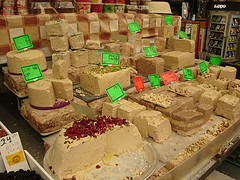Back in the 1960's Nancy Sinatra made it big on the music scene thanks to her hit These Boots Are Made For Walking and its popular refrain: One of these days these boots are going to walk all over you.
Did she have Haman in mind when she sang this song? Sure enough one of the Purim customs I recently found is to write the name of Haman on the sole of your shoes, and stamp your feet really hard every time Haman's name is called out during the Megillah reading until his name is erased. Unfortunately, this custom was not connected to a specific country but it did remind me of a French Purim custom that I posted in 2010 in which Haman's name was either printed or engraved on 2 stones knocked together during the Megillah reading.
Contact me if you have any other creative customs for obliterating Haman's name. I'll be happy to post them.
Purim Sameach. Happy Purim.
Photo credit
Sunday, February 26, 2012
Sunday, February 12, 2012
A Purely Persian Purim
Meet Queen Esther. At least that's who I'd like to think this lady is, for who else would be depicted on a 17th century tile made in Isfahan, Iran, depicting an Iranian Jewess?
I have been fascinated by Iranian Jewry for over eight years -- from the moment I discovered Esther and Mordechai's mausoleum while surfing the net. It is located in the Iranian city of Hamadan, also famous for its Persian carpets. The minute I landed on this Jewish tourist site I began to look at Purim in a purely Persian light. No longer did it seem a mythical tale meant for a carnival celebration. So serious is this holiday that most Jews living in Iran -- secular and religious alike -- observe the Fast of Esther. Nothing is closer to home for them than Purim, with Esther and Mordechai part of their persona.
You can imagine the culture shock Iranian Jews experienced after the 1979 revolution, when many sought safety in the United States and Purim rolled around. Little of what they witnessed was recognizable. Costumes? Certainly NOT a Persian custom. Same for Mardi Gras type merrymaking. Drowning out the name of Haman during the megillah reading through a cacophony of noise? Yes, but only one of their Haman traditions. While hanging effigies of Haman in backyards and burning them was no longer widespread (I assume for reasons of political correctness), some families wrote and sang their own songs about the insidious villain. Haman aside, giving children gifts and coins was a commonplace tradition, providing Purim with an atmosphere we associate with Hanukkah. Finally, Mishloach Manot came in only one form, and it wasn't a basket full of goodies. Homemade halva (much like these Israeli varieties) presented on a plate was the Persian preference, and the most widespread symbol of Purim.
Today, Iranian Jews have successfully assimilated into the American way of life, leaving "the old country" and much of its ways behind. Last year I met a group of American-Iranian Jewish teens studying in Israel. Sadly, they barely knew about these traditions. How unfortunate in this multi-cultural age.
Hopefully this post will help bring Persia back into Purim. To make it even more authentic, take your students and children on this virtual tour of Esther and Mordechai's mausoleum. Like Jerusalem's Western Wall, it was the place Iranian Jews went to pray, cry and make special requests.
Enjoy your Persian Purim. Make it meaningful and merry at the same time.
Tile photo credit
Halva photo credit
I have been fascinated by Iranian Jewry for over eight years -- from the moment I discovered Esther and Mordechai's mausoleum while surfing the net. It is located in the Iranian city of Hamadan, also famous for its Persian carpets. The minute I landed on this Jewish tourist site I began to look at Purim in a purely Persian light. No longer did it seem a mythical tale meant for a carnival celebration. So serious is this holiday that most Jews living in Iran -- secular and religious alike -- observe the Fast of Esther. Nothing is closer to home for them than Purim, with Esther and Mordechai part of their persona.
You can imagine the culture shock Iranian Jews experienced after the 1979 revolution, when many sought safety in the United States and Purim rolled around. Little of what they witnessed was recognizable. Costumes? Certainly NOT a Persian custom. Same for Mardi Gras type merrymaking. Drowning out the name of Haman during the megillah reading through a cacophony of noise? Yes, but only one of their Haman traditions. While hanging effigies of Haman in backyards and burning them was no longer widespread (I assume for reasons of political correctness), some families wrote and sang their own songs about the insidious villain. Haman aside, giving children gifts and coins was a commonplace tradition, providing Purim with an atmosphere we associate with Hanukkah. Finally, Mishloach Manot came in only one form, and it wasn't a basket full of goodies. Homemade halva (much like these Israeli varieties) presented on a plate was the Persian preference, and the most widespread symbol of Purim.
 |
Today, Iranian Jews have successfully assimilated into the American way of life, leaving "the old country" and much of its ways behind. Last year I met a group of American-Iranian Jewish teens studying in Israel. Sadly, they barely knew about these traditions. How unfortunate in this multi-cultural age.
Hopefully this post will help bring Persia back into Purim. To make it even more authentic, take your students and children on this virtual tour of Esther and Mordechai's mausoleum. Like Jerusalem's Western Wall, it was the place Iranian Jews went to pray, cry and make special requests.
Enjoy your Persian Purim. Make it meaningful and merry at the same time.
Tile photo credit
Halva photo credit
Subscribe to:
Posts (Atom)


